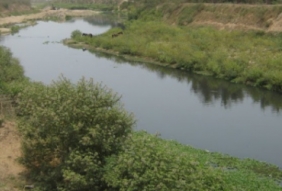
Posted on December 17, 2015
Local governments are cutting their losses on a beleaguered plan to revitalize an 18-mile stretch of the Santa Cruz River.
The Marana Town Council voted unanimously Tuesday to withdraw as a local sponsor of the Tres Rios del Norte feasibility study. The study, and its resulting initiatives, would have helped restore the ecosystem and replenished the groundwater supply on a stretch of river running from Prince Road to Sanders Road.
The rising cost and scarcity of water, and the unlikelihood of securing federal funding to help implement the study’s recommendations, made the ambitious project unrealistic, officials said. The town will instead focus on more modest and sustainable ecosystem restoration projects, Keith Brann, Marana town engineer, said Tuesday.
“The biggest issue is the water that would be needed ongoing to keep it alive, to keep the mitigation viable,” he said. “Water is a very scarce commodity for the town of Marana. Scaling it back into smaller projects that are more achievable is the right way to go, we think.”
The Tres Rios del Norte study was originally launched in 2001 as a partnership between the U.S. Army Corps of Engineers, Marana, the Pima County Regional Flood Control District and the city of Tucson. It aimed to regenerate the riparian habitat that once flourished along the Santa Cruz River.
The feasibility studies focused on ways to reduce flood damage, recharge groundwater, restore the ecosystem and create options for recreation.
A draft plan resulting from the study estimated the restoration’s cost at $300 million.
“It was economically not feasible,” Pima County administrator Chuck Huckelberry said Tuesday.
With Marana stepping aside, and Tucson having left the project in 2009, Pima County now plans to partner one-on-one with the Army Corps of Engineers to focus on a scaled-down version of Tres Rios. It will likely center on restoring the riparian area around the confluence of the Santa Cruz, Rillito and Cañada del Oro rivers, Huckelberry said.
Restoration will use vegetation like mesquites and palo verdes that require less water than the cottonwoods that once lined the riverbeds, he said. That was before decades of development depleted the groundwater supply, he said.
The Tres Rios del Norte project has been beset by barriers — from the Great Recession to persistent drought — for years. Rising water prices meant the cost to Marana would be much higher than originally projected, said Jennifer Christelman, assistant engineering director for Marana.
When Tucson decided to pull out, the project lost a local player with the largest allocation of water from the Central Arizona Project. New estimates for the restoration project’s annual costs surpass $18 million annually, including purchasing water, Christelman said.
The Obama administration also changed its restoration priorities to focus on “aquatic” projects, like cleaning up running rivers, which puts desert projects — involving rivers that are dry most of the year — at a disadvantage in competing for federal dollars, said John Drake, senior project manager for the Army Corps of Engineers. He has managed Tres Rios del Norte for most of the project’s lifespan.
“We still did really great work,” Drake said. “It’s a journey and sometimes you’re able to build what you’ve proposed and sometimes it just doesn’t get there.”
WORTH THE EFFORT
Since 2001 the U.S. Army Corps of Engineers, Marana, Pima County and Tucson have spent a combined $7.7 million, Drake said.
Included in that figure: Marana has spent $385,000 in cash, and an additional $722,000 worth of staff time, on the study, Christelman said.
But she said the expenditure hasn’t been a wash.
Tres Rios research — including hydrology studies and analyses of cultural, environmental and real estate impacts of potential projects — will guide future restoration efforts and have helped staffers identify potential project sites, she said.
“The number of studies and amount of information we’ve gained over the 15 years is definitely not lost,” Christelman said. “There’s a lot of benefit to that, for whatever projects we decide to move forward with. We have a ton of good information.”
One promising site in Marana’s jurisdiction is a flooded pit in the El Rio area, near the Continental Ranch development, which flooded with water from the Santa Cruz River during storms last year.
The 50-acre pit, now known locally as Marana Lake, “showed it’s viable as a possible lake and wildlife refuge area,” Brann said.
The site is in a wildlife corridor between the Tucson Mountains and the Tortolita Mountains and could become a draw for bird and other wildlife viewing. Marana engineers have also discussed adding cycling and pedestrian trails, he said.
Christina McVie, conservation chair for the Tucson Audubon Society, said Marana’s move to withdraw and the plan for a scaled-down Tres Rios project have been a long time coming.
“Both the county and Marana and others will be partnering on small projects that more accurately reflect their priorities,” she said Tuesday. “We look forward to seeing what they all come up with and hoping to support it.”





